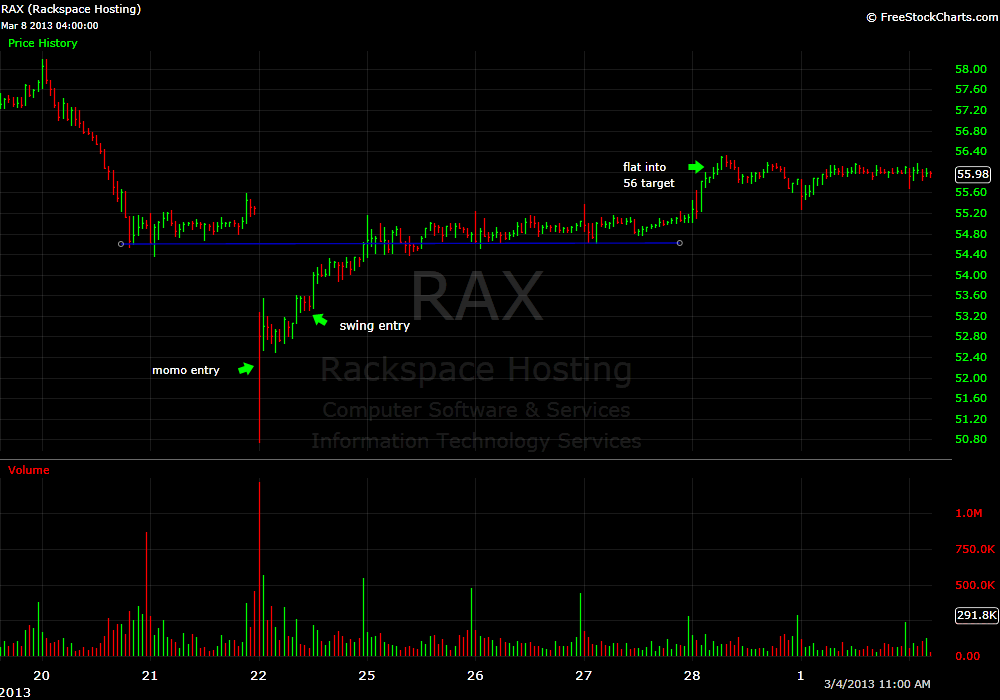In October 2009 I began talking to our desk about “Intraday Swing Trading”. This discussion was preceded by about six months of mounting frustration from a large group of traders. Our desk at the time consisted largely of traders we trained in 2007-2008 a time of extreme volatility in the market that favored a very aggressive style of momentum trading. Our most aggressive trainees thrived during that time period. But once the market bottomed they struggled the most. How do you tell a trader with 18 months of experience who had made huge money during their first year of trading that if they don’t adjust their style they will probably not make it to month 24?
I began “Trades of the Week” in earnest. I discussed the best technical and catalyst driven day trading strategies for the prior week many of which were Trades2Hold in SMB parlance, and some which morphed into multi-day swings based on their closing price action on Day 1. The biggest difference I see in pure swing traderswho look to enter positions based on a setup being confirmed at the close of Day 1 and intraday traders who will enter based on a lower time frame setup is the risk/reward for their trades. Planned swing trades usually offer a risk/reward of 1:2 or 1:3, whereas precise intraday entries bump those ratios to 1:5 and higher.
Here are examples of the three overnight swing positions I had during the last two weeks. RAX and GMCR were winners and KERX was a loser. The average risk on the positions was about 20 cents from the entries that led to each becoming a swing trade. The final closeouts on the winners were $2.60 from the entries and I got flat KERX 13 cents below my entry.
The GMCR setup was a technical setups in a Top 5 momentum stock. I have written numerous times about these stocks in posts labeled “the money trade” and in StockTwits Edge. In addition to having a great setup the day after they report earnings they continually setup for technical breaks where the momo funds pile in and out for a few days. Recognizing these setups early can get you involved while the risk is 1:10 or better. They are also great swing trades as they tend to have multi-day follow through.
The setup in GMCR was it had been consolidating tightly against the recent pivot high. The plan was to get long above 49.25 on the Open and then build a position on a hold above 49.60. I had to adjust the plan as GMCR was bid up in the pre-market to 50. I may have played a role in that run up as I shared the idea on StockTwits in pre-market and it seemed to react to my message. I got long above 50 on the Open and was stopped out of that position for a small gain before re-entering at 50.32, which became a swing position as it closed at HOD. I was stopped out below 52.90 Friday afternoon when it failed to hold above 53 and push to my original 54 target.
This trade was triggered by an “exhaustion bottom” being put in after RAX announced that they were slashing prices. My initial thought with this news was that it would establish an intermediate term bottom, but I waited for the price action on the Open to confirm my thesis rather than buying into the pre-market weakness. After it began to consolidate above its Opening Range I established my swing position. It closed in the top 20% of its range so it became an overnight swing for me. Exited when it traded into my 56 target a few days later.
This was a combination technical trade and “small biotech trade”. In late January KERX had run from 5 to 10 in a few days after breaking weekly resistance. After moving sideways for a couple of months it was starting to show signs that it would break back up to 10 when it popped on heavy vlume on March 1st. After comressing for 1 1/2 days it drove above 7.30 triggering my alert. I bid in front of 7.30 and placed my stop below 7.20. I was stopped out the following day for a small loss.
Steven Spencer is the co-founder of SMB Capital and SMB University and has traded professionally for 16 years. His email is [email protected].
No relevant positions




